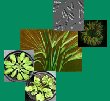| Lüttge, U; Berg, A; Fetene, M; Nauke, P; Peter, D; Beck, E: Comparative characterization of photosynthetic performance and water relations of native trees and exotic plantation trees in an ethiopian forest, Trees, 17, 40-50 (2003), doi:DOI:10.1007/s00468-002-0201-7 | |
| Abstract: Comparative ecophysiological studies by measurements of photosystem II chlorophyll a fluorescence, porometry and stable isotope analyses were performed on regrowth of trees in a plantation of Eucalyptus saligna in Ethiopia. In the Shashemene-Munessa State Forest of the eastern escarpment of the Great Rift Valley, young plants of E. saligna and the native tree Podocarpus falcatus were compared under the canopy of an established E. saligna plantation, and the native tree Bersama abyssinica was also included. For further comparison fully sun-exposed plants of Eucalyptus globulus in a young newly established plantation, and trees of P. falcatus and the native pioneer tree Croton macrostachys in a remnant natural forest were examined. Photosynthetic yield measurements and light response curves suggested a gradation of sun-adapted to shade-adapted behaviour of E. globulus (exposed) >C. macrostachys >>E. saligna (understorey) ≥ P. falcatus ~ B. abyssinica. As indicated by carbon isotope discrimination, long-term water-use efficiency (WUE) tended to be higher in P. falcatus than in E. saligna in the understorey of the plantation. Transpiration measurements showed that Eucalyptus spp had the highest and P. falcatus the lowest instant leaf conductance for water vapour. Thus, P. falcatus competes well photosynthetically and by a more favourable WUE. These measurements support the expectation that the E. saligna plantation has a nurse effect for regrowth of native trees. With the management practice of regularly coppicing E. saligna in a 7-year rhythm a native P. falcatus forest may regenerate. |

Letzte Änderung 07.10.2020

